|
October 7, 2006
Hello from Nova Scotia: Enjoying Halifax'
Harbourwalk and Learning about Canada's Immigration History at Pier
21
My Halifax City Tour, expertly
narrated by Allen Mackenzie, a passionate Haligonian in a kilt,
had provided me with a great overview of this city, and my visit
to the Maritime Museum of the Atlantic had added to my knowledge
of Halifax, particularly of its connection to the Titanic and the
1917 Explosion. Still mulling over the historic significance of
this city, the largest population centre on Canada’s East
Coast, I sat down close to the waterfront to finally have lunch
and strengthen myself after an intense introduction to the city.
On this sunny, fairly warm day I had a seat on the outdoor patio
of Stayner’s Wharf, one of the restaurants on the Waterfront,
located right next to the Halifax – Dartmouth Ferry Terminal.
I was finally able to catch a rest, relax in the autumn sun and
get ready for my lunch. I ordered the “Captain’s Brunch”,
a pan-seared brunch-size portion of Atlantic salmon with one lightly
fried egg, creamy whipped potatoes topped with a bit of Hollandaise
sauce, served with a slice of tomato and cucumber. It was a very
satisfying lunch, looking out onto Halifax’ waterfront, with
a view of the Theodore Too, Halifax’ famous TV-show inspired
tugboat.
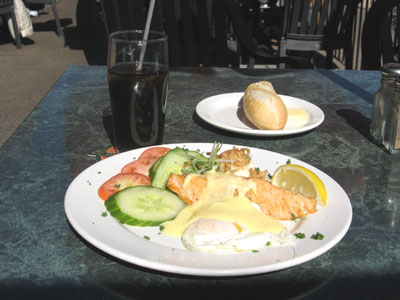
A well-deserved lunch by the water
I took about half an hour before I got up and made my way southwards
on the Harbourwalk, Halifax’s 3.8 km boardwalk that stretches
all the way from Casino Nova Scotia in the north to the Pier 21
National Historic Site in the south. More than 2.5 million visitors
walk the Harbourwalk annually. $31 million were invested in order
to purchase and rejuvenate properties and to renew infrastructure.
The Harbourwalk is composed of a series of public parks, wharves
and plazas all connected by a boardwalk system that is primarily
wooden to reflect the historic marine character of Halifax's waterfront
which is now easily accessible to the public. People were out in
full force, enjoying the pleasant weather. Several street comedians
were performing right next to the waterfront, drawing huge crowds
of onlookers.
The Halifax Harbour actually is one of the world’s best natural
harbours as it extends almost 20 km inland into the Bedford Basin.
Several islands are located in the harbour. The closest to the harbour
entrance is George’s Island which has been designated a National
Historic Site although it is not currently accessible to the public.
This island has long played an important role in the harbour’s
defense system.
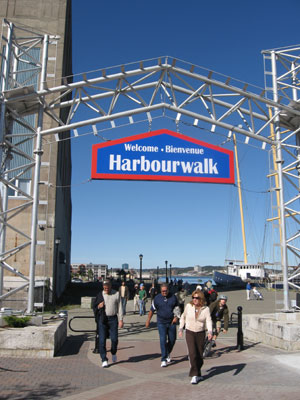
Halifax Harbourwalk
McNabs Island is located farther out in the harbour and is accessible
via a ferry from the Eastern Passage or via a charter boat from
Cable Wharf. This island was settled in the past although the homesteads
are now abandoned. A lighthouse, ruined fortress and batteries as
well as sand beaches can be found on McNabs Island. One more island,
Lawlor’s Island, is located close to the mainland. It never
had any military installations and today is a protected nature area.
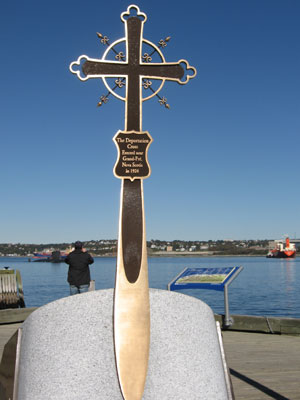
A replica of the Deportation Cross at the Grand Pré
The Halifax harbour also features a deportation cross, reminiscent
of the famous deportation cross at the Grand
Pré, the original deportation site of the Acadian Expulsion.
And being Canada’s major seaport on the east coast, it has
always had a strategic military role and even today features key
military installations.
As I was walking along Harbourwalk, I saw various ships passing
in and out of the narrow passage, but the most interesting one was
a military submarine, with all the sailors standing on deck, often
waving to the fascinated audience on land. I was wondering when
the sailors would disappear below deck, but I lost sight of them
as I walked southwards towards the pier buildings.
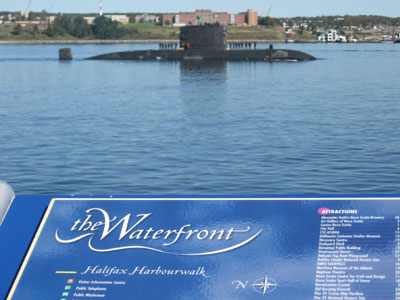
A submarine sails out towards the Atlantic
Halifax is a true centre of ocean transport due to being blessed
with one of the world’s deepest and largest natural harbours.
The harbour’s waters remain ice-free and experience minimal
tides and the port generally is the first inbound and the last outbound
port to North America from Europe, the Mediterranean and the Suez
Canal. It is also a major cruise ship centre: in 2005 108 cruise
vessels with over 188,000 visitors docked in Halifax, causing a
major economic infusion for the city.
In line with the ocean transportation theme, a monument to a famous
Halifax resident is located just south of the entrance gate to the
Halifax Port area: Samuel Cunard (1787 to 1865) , a native son of
Halifax, is forever commemorated in a bronze statue that prominently
presides over the Port of Halifax. Cunard became a Nova Scotia shipping
magnate, whose Cunard Steamship Line would run many of the famous
transatlantic ocean liners in the 1800s. His primary competitor
was the White Star Line, whose ill-fated ocean liner Titanic sank
750 km off the coast of Nova Scotia in 1912. After this disaster,
Cunard dominated the transatlantic passenger shipping and his company
became one of the most important companies in the world. The Cunard
line’s fortune began to decline in the 1950s when air travel
became popular, but over the last few years has experienced a major
revival with the world renowned Queen Mary 2, the first ocean liner
to be built in 30 years, and the largest passenger liner ever built.
In 1998 Cunard was taken over by Carnival Corporation, but the Cunard
name can still be seen on the side of the Queen Mary 2.
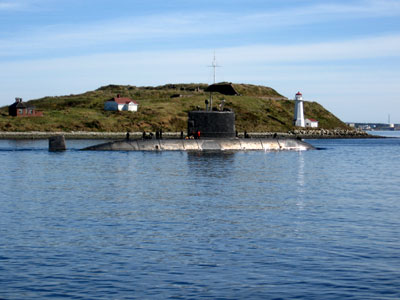
The submarine in front of George's Island
I was in luck, because as I strolled closer to the pier buildings
in the Halifax Port area, I saw that the Queen Mary 2 was indeed
in town. An impressive ship, it appears to be about 8 to 10 stories
tall and towers over the port buildings. Right here, with the Queen
Mary 2 as a backdrop, I had reached my next destination: Pier
21, Canada’s immigration museum.
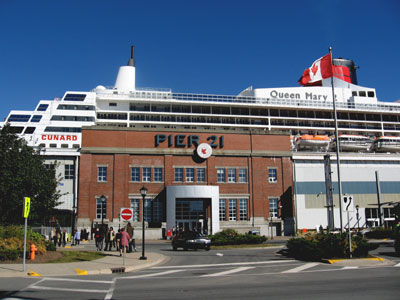
Pier 21 with the Queen Mary 2 in the background
Upon arrival I connected with Stefani Angelopoulos, Communications
Manager for the museum who was so kind to give me a personalized
tour through this unique facility. Pier
21 is the Canadian equivalent to Ellis Island: more than a million
immigrants came through its doors between 1928 and 1971. Until its
opening in the late 1990s, the building sat empty as a warehouse
and was finally turned into a museum in 1999 and designated as a
National Historic Site. It was also the embarkation point for about
500,000 soldiers who were transported from here to fight in the
Second World War. Halifax’ strategic importance in linking
Canada with Europe became evident once again.
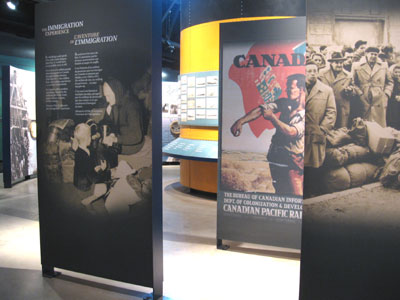
Pier 21 exhibits
Stefani informed me that between 1942 and 1948, more than 48,000
War Brides came to Canada from Britain and other countries in Europe
and they brought 22,000 children with them. They had fallen in love
with Canadian soldiers and were ready to start their new life in
Canada. The vast majority arrived in 1946, 60 years ago, and made
their first connection with their new homeland right here in Halifax,
at Pier 21. Many then took a train from here to start their new
lives in other parts of the country.
I learned that to commemorate the 60 year anniversary, Via Rail
came up with a special event in celebration of this occasion: the
2006 War Bride Train which is scheduled to bring hundreds
of Canadian War Brides back to Pier 21 where their lives in Canada
began. On November 6 the train will depart in Montreal and arrive
on November 7 in Halifax where there will be great opportunities
for celebration and reminiscing for hundreds of War Brides. Stefani
commented that Pier 21 is linked to so many moving human stories
that sometimes it is hard to keep a dry eye.
We started our tour at the Research Centre downstairs which has
a collection of photographs of over 90% of the ships that transported
immigrants to Halifax from 1928 to 1971. Images and newspaper photographs
tell the diverse stories of immigrants, mostly from Western Europe
and the Mediterranean area. Many images also relate to the almost
half a million Canadian troops that departed from Pier 21 in Halifax
to join the war effort in Europe during the Second World War.
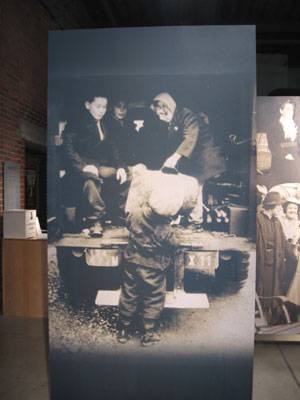
Pier 21 exhibit
The Research Centre also provides public reference for all ocean
immigration records from 1925 to 1935 and many Canadians specifically
come to Pier 21
to research their parent's or grandparent's arrival
records in Canada. Four computer terminals provide access to the
website, to the stories database, the ship database and other electronic
resources related to immigration. Microfilm records contain the
responses to 28 questions that a prospective immigrant would have
to answer prior to being allowed to enter Canada. These microfilms
are some of the most popular records in the Research Centre.
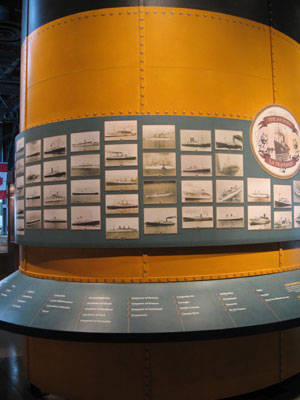
Images of ships that brought immigrants to Canada
Although I have no personal connection to Pier
21, having arrived by myself in Toronto without family in 1986,
Carrie-Ann Smith, Pier 21’s Manager of Research, provided
me with a copy of the entire chapter on German and Austrian immigration,
taken from the Encyclopedia of Canada’s People’s, edited
by Paul R. Magocsi, and published in 1999 by University of Toronto
Press. I found out that about 31,000 Austrian immigrants came through
Pier 21 from 1928 to 1971, compared to 1,152,400 immigrants from
the United Kingdom and 527,000 immigrants from the United States.
In addition to 48,000 War Brides and their children, many
refugees and displaced persons also came to Canada during
these years, including about 69,700 Jewish immigrants, many of whom
were victims of the Holocaust. In addition, Canada also welcomed
about 3,000 Evacuee Children from the United Kingdom who
were evacuated during WWII due to the heavy bombing raids and the
perceived threat of invasion. More than 250,000 children were supposed
to be evacuated, but one of the ships transporting children was
sunk by enemy ships so the program was cut short.
Another category of immigrant were the Home Children: more
than 100,000 left Great Britain between the late 1860s and the mid
1930s due to the extreme poverty in their home country. These children
would typically be employed either as domestic help or farm labourers,
and the practice was already dwindling when Pier 21 opened in 1928.
Stories representing the almost half a million WWII veterans
who embarked for military service in Europe from Pier 21 during
the Second World War, can also be found here. The human stories
of so many different types of people provide fascinating insights
into one of the most turbulent times of human history and Canada’s
role in it.
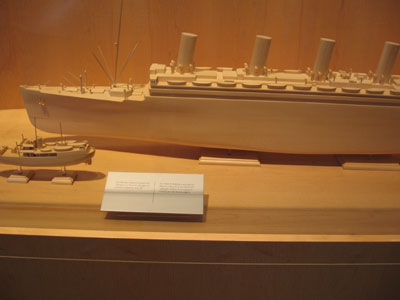
Pier 21 is certainly one of Canada’s most unique museums,
testimony to the key role that immigration has played and continues
to play in this country. You enter the museum and arrive in a large
exhibition hall, the Kenneth C. Rowe Heritage Hall, a multi-purpose
area that can also be rented out for private functions which holds
up to 600 guests. Up the elevators you arrive in the main exhibit
area which features a wide variety of exhibits illustrating the
immigration experience. The Rudolph Peter Batty Exhibition Hall
allows you to retrace the steps of an immigrant who just arrived
at the Halifax Harbour, complete with wooden waiting benches and
an immigration officer’s desk. The Wall of Ships features
images of many of the ocean liners that used to transport thousands
of immigrants to their new home country. A replica of a Canadian
National Railway car conjures up memories of the train journeys
that so many immigrants took across Canada to their new homes in
different parts of the country.
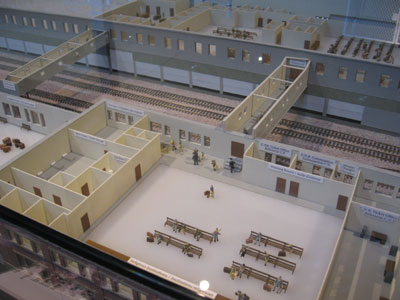
Six video booths provide access to video clips featuring the story
of immigrants from different places. As a Canadian immigrant from
Austria, I sat down in the first video booth where an Austrian video
testimonial was being played and I saw the story of an Austrian
immigrant , a man who had come to make his life in Canada in the
1950s. His emotion and gratefulness to his new country were clearly
visible.
The Andrea and Charles Bronfman In-Transit Theatre at the
far end of the exhibition space features a 24 minute virtual projection
presentation that portrays the emotional stories of those who passed
through these historic halls. Stefani pointed out that the volunteer
guide who was supervising the presentation was a very special person:
Robert Vandekieft is an 89 year old individual who volunteers at
Pier 21 three days a week. But not only does Robert give his personal
time to this unique museum, he actually came through the doors of
Pier 21 as an immigrant himself in 1954 to start his new life in
Canada.
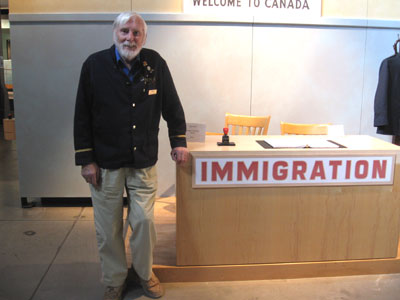
Robert Vandekieft, Pier 21 volunteer and Canadian immigrant
Robert originally is from Haarlem, a town in northern Holland and
decided to make his new life in Canada. Three months after his arrival
in 1954 his wife and children followed. Robert fondly recalls a
story of his family’s arrival: he had bought a teddy bear
for his older son and upon arrival tossed it up to the top level
of the ship where the boy successfully caught it. He had also bought
some plastercene for his younger son as a present which he tossed
up towards his younger child.
Unfortunately his throw was off and the plastercene fell into the
water, but thanks to the kindness of the longshoremen of the Halifax
Port, they fished it out of the water and brought it back to Robert
so he would be able to give his younger son a proper welcome gift.
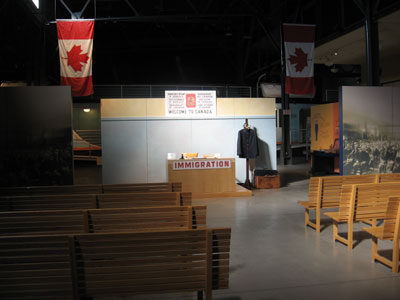
The created immigration waiting hall at Pier 21
Robert had originally travelled to Winnipeg where he was hired as
a fur dyer, his original occupation. But he did not like his job
there very much, so after a few weeks he travelled back to Nova
Scotia where he was offered a job on a farm. After his family’s
arrival Robert found out that his wife was not at all keen on farming
so he looked for another job. He started working for Canada Packers
in the warehouse and would regularly lift sides of beef with a weight
of up to 62 pounds.
After 8 months he applied for a job as a stagehand with the CBC
(Canadian Broadcasting Corporation), then he moved up in the ranks
to crew header and later to become the supervisor of the design
department. As his career progressed, Robert Vandekieft became a
producer and director at the CBC and his career ended with senior
roles in educational television. One of Robert’s last shows
before his retirement was a 5-part series on the Mi’kmaq First
Nations People filmed in their native language. What a Canadian
success story!
Obviously this man at almost 90 years of age is able to look back
on a long and interesting life of which he has spent 52 years in
Canada. I asked Robert what he thought about Canada and his face
lit up with a huge smile: “I love this country!”
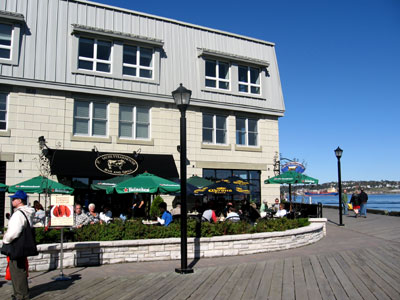
Halifax Harbourwalk
Robert has been honoured as the “Maritimer of the Week”
and he smiles when he says that his granddaughter nominated him.
He loves volunteering for Pier
21 and has been doing it for almost five years now.
Although my visit at Pier 21 was cut short because of my tight schedule
(I still needed to see Dartmouth
on my last afternoon in Nova Scotia), I was touched by all the human
stories of Pier 21, represented first and foremost by the living
testimonial of Robert Vandekieft, who, like thousands of others,
turned his arrival at Pier 21 into the first step of a long and
successful life in Canada.
Useful
books about travel to Nova Scotia:
Related
articles:
My five whirlwind days in Nova Scotia
Acadian
history at the Grand Pré National Historic Site
400 years of history at Annapolis
Royal
Port-Royal, a French habitation from 1605
Dinner at the Garrison House
in Annapolis Royal
The Annapolis Royal
Graveyard Tour
The Garrison House Bed and Breakfast
Exploring the Evangeline Trail from
Annapolis Royal to Yarmouth
Learning about Mi'kmaq heritage at the
Bear River First Nation Heritage and Cultural Center
Victorian heritage in Yarmouth
The MacKinnon-Cann Inn: Where Home
and Garden Television meets the Travel Channel
Yarmouth explained - the Yarmouth
County Museum
My car is in the ditch in Chebogue
River
The Lighthouse Trail from Yarmouth
to Shelburne
The Lighthouse Trail from Shelburne
to Lunenburg
The Town of Lunenburg - a UNESCO World Heritage
Site
An interview with the owners of the
Lunenburg Inn
The Lighthouse Trail from Lunenburg to
Halifax via Mahone Bay and Peggy's Cove
Arrival in Halifax and a stunning
musical performance - DRUM!
A Halifax city tour, the city's
connection to the Titantic and the 1917 Halifax Explosion
Exploring the Halifax Harbourwalk and
Pier 21 - Canada's immigration museum
A ferry trip to Dartmouth and saying
goodbye to Halifax
An interview with Pier 21 -
Canada's immigration museum
Helpful
links for travel to Nova Scotia:
Tourism
Nova Scotia
Destination
South West Nova Scotia
Halifax Tourism
|